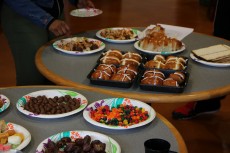The religious meaning of foods

Students learned about and sampled religiously significant foods from a variety of cultures and created their own mandala during an event sponsored by the Department of Religion on March 23.
The colorful array of delicacies included dates, Indian sweets, and bread.
The Muslim prophet Muhammad “would break the fast by eating dates,” Associate Professor of Religion Ben Zeller explained to the group. “Indian sweets are used in Hinduism and offered first to a deity.”
The group also sampled Jewish challah bread. “In Exodus, slaves would get two pieces of bread on Fridays and only one on the other days of the week,” Zeller said.
Zeller is an expert in field of religion and food. He edited Religion, Food, and Eating in North America (2014), has presented talks about religion and food, and been quoted in the media about this emerging field of expertise.
Participants also had an opportunity to color their own mandala, which is a geometric figure representing the universe in both Hinduism and Buddhism.
“The party occurred in between a number of religious holidays,” said Kristin Rawlings ’19. “For Judaism, it was Purim and Passover. For Christianity, it was Ash Wednesday, Lent, and Easter.” A religion major, Rawlings is a member of the Department of Religion Student Academic Advisory Committee. “We really wanted the party to be a celebration of all religious cultures and the diversity of their practices.”